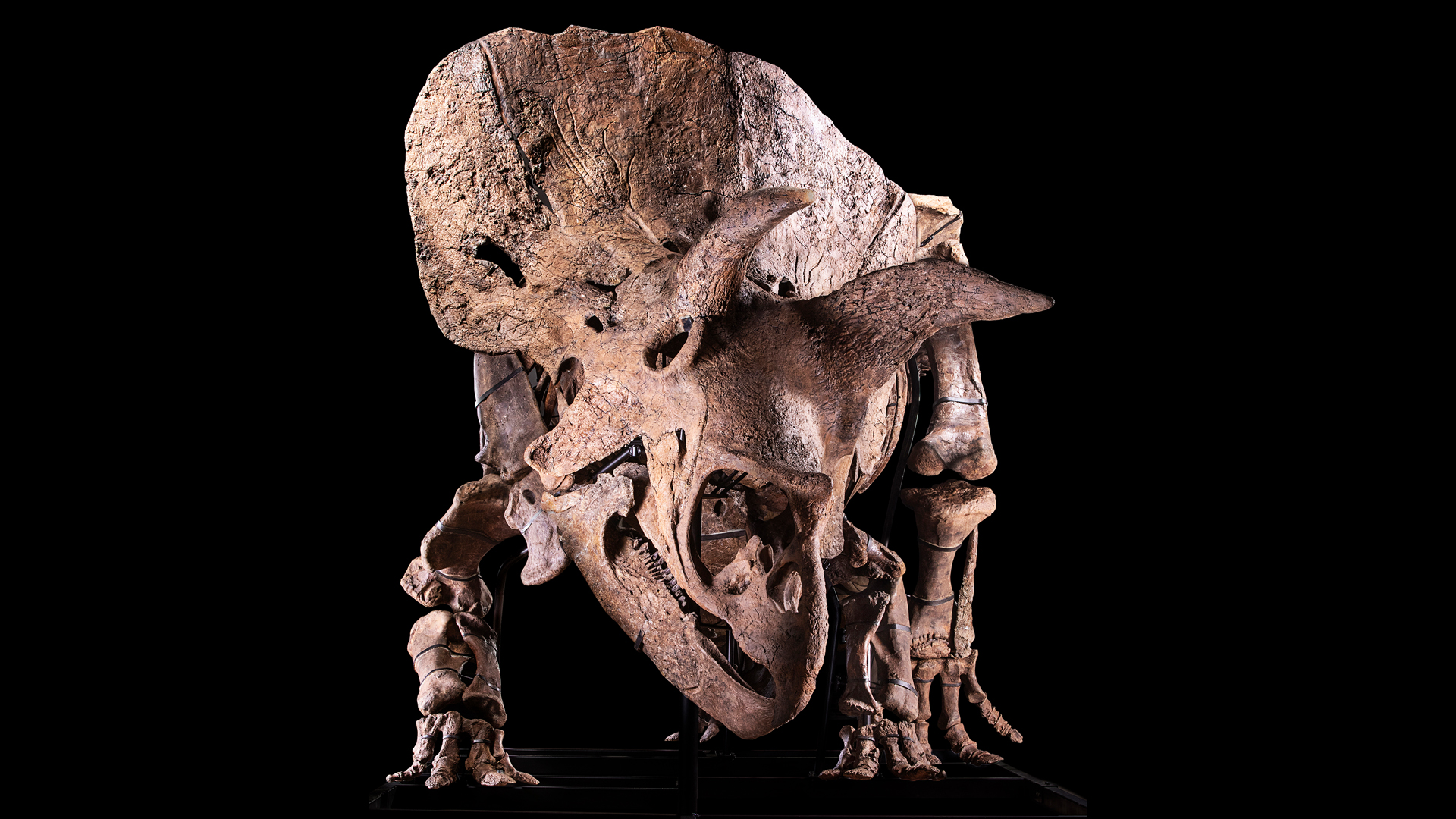Who will buy 'Big John,' the biggest triceratops ever found?
The massive fossil will be on display in Paris from Sept. 16 to Oct. 15.

An enormous triceratops nicknamed "Big John" is expected to fetch big bucks on the auction block in France, in October.
The skeleton, which is more than 66 million years old and is approximately 60% complete, is the largest triceratops ever found. It measures about 26 feet (8 meters) long; the skull, which is 75% complete, is 6.6 feet (2 m) wide.
French auction house Giquello will display the massive fossil to the public from Sept. 16 to Oct. 15 at 13 Rue des Archives in Paris, Giquello representatives said in a statement. Then, on Oct. 18, the giant dinosaur fossil will make its debut appearance at the Parisian auction house Hôtel Drouot, where it will be auctioned on Oct. 21 to the highest bidder as part of Giquello's "Naturalia" auction. Big John is expected to fetch between $1.4 million and $1.8 million (1.2 million and 1.5 million euros), according to the statement.
Related: Tiny & old: Images of 'triceratops' ancestors
Frilled, tri-horned triceratops inhabited North America about 67 million to 65 million years ago during the Cretaceous period (145.5 million to about 65.5 million years ago). Big John lived in what is now South Dakota on an island continent called Laramidia, which formed during the latter part of the Cretaceous when a shallow sea flooded North America's central region.
The fossil was discovered in 2014 by paleontologist Walter W. Stein, owner of the independent commercial paleontology company PaleoAdventures in South Dakota. Stein excavated the skeleton from the Hell Creek Formation, an ancient flood plain and a rich fossil site that spans parts of Montana, North Dakota, South Dakota and Wyoming. Much of the formation is on state and federal lands, according to the University of California Museum of Paleontology at Berkeley.
Millions of years ago, Big John died and was covered by thick mud, which enabled the bones to fossilize. A preserved notch in his collarbone suggests that the triceratops was wounded during violent combat, possibly during a tussle with another triceratops over mates or territory, according to the statement.
Sign up for the Live Science daily newsletter now
Get the world’s most fascinating discoveries delivered straight to your inbox.

The other triceratops may have fared even worse in that battle: Big John's two largest horns each measure nearly 4 feet (1.1 m) long and almost 1 foot (30 centimeters) wide at the base, and can withstand about 16 tons (14.5 metric tons) of pressure, representatives said.
Other dinosaur fossils have commanded even heftier price tags at auction than Big John is likely to. In October 2020, a 67 million-year-old T. rex named Stan sold at auction for a record-breaking $31.8 million, making it the most expensive fossil of all time. Sales of high-profile fossils have raised concerns among paleontologists that museums and other scientific institutions will be outbid on valuable specimens, which will then disappear into private collections and be lost to researchers, Live Science previously reported.
Originally published on Live Science.

Mindy Weisberger is an editor at Scholastic and a former Live Science channel editor and senior writer. She has reported on general science, covering climate change, paleontology, biology and space. Mindy studied film at Columbia University; prior to Live Science she produced, wrote and directed media for the American Museum of Natural History in New York City. Her videos about dinosaurs, astrophysics, biodiversity and evolution appear in museums and science centers worldwide, earning awards such as the CINE Golden Eagle and the Communicator Award of Excellence. Her writing has also appeared in Scientific American, The Washington Post and How It Works Magazine. Her book "Rise of the Zombie Bugs: The Surprising Science of Parasitic Mind Control" will be published in spring 2025 by Johns Hopkins University Press.









